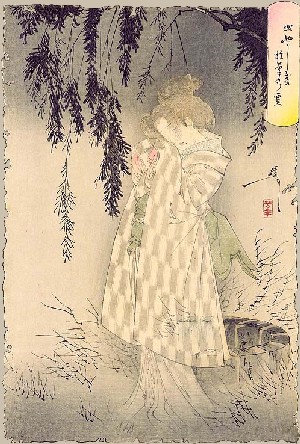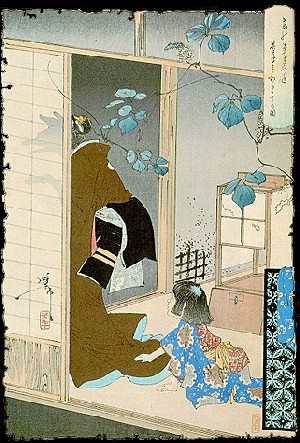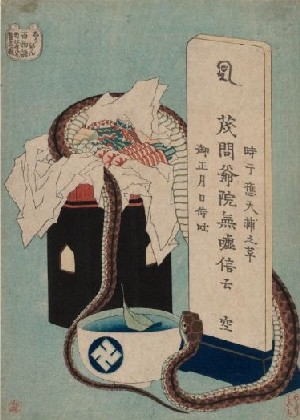| architecture |
| calligraphy |
| ceramics |
| clothing |
| comics |
| gardens |
| lacquerwork |
| literature |
| movies |
| music |
| painting |
| poetry |
| sculpture |
| tea ceremony |
| television |
| theatre |
| weaponry |
| thematic routes |
| timeline |
| the site |
context: thematic routes
Horror and the Supernatural
Since the links to the right, expanding on or illustrating the comments here, can go to anywhere on the site (sometimes to whole sections with dozens of pages) they each open in a new window, so that this page can be retained as master context when you have finished exploring. |
|||
It was particularly the wave of excellent Japanese horror movies that started me thinking about this subject. Watching them, I wondered if their impact in the West might owe something to their arising from a tradition that isn't as played out as most of our Western horror subgenres. Vampires, werewolves and so on are very familiar to us, so creators have to work hard to find new angles, whereas the Japanese movies have the head start of being original to us, of playing by different rules, even if that is not the case for their home audience. Perhaps the same is true of Japanese comics. |
horror movies horror comics | ||
So I want to say something about the place of horror and the supernatural in other Japanese forms. I think the first key point relates to another essay I plan to write sometime soon: the place of morality in the Japanese psyche. It's a much smaller place, largely due to the more minor role it plays in their old religions. There isn't the straightforward division of the supernatural world into absolute metaphysical categories of good and evil - almost all of their supernatural beings and monsters are equivocal in these terms, sometimes good and sometimes evil, not necessarily fundamentally either by their nature. In many tales, no such decision is ever so much as considered - the creatures act in their own ways, and this has disruptive or malign effects on the humans in the story, but this is not always because the creatures are being evil. |
|||
Another relevant point discussed elsewhere is the Japanese attitude to stories - I suggest in my essay on realism that fictional characters are not empathised with as much as in the West, and this means much more horrible things can happen to them without audience outrage. Takashi Miike's 'Audition' might be a good example. |
realism essay presentation/representation in movies | ||
Supernatural creatures |
|||
It's probably worth introducing some general description of the denizens of the Japanese supernatural world. |
|||
Oni are, more or less, demons, guardians of the gates of the Buddhist hell. This does not mean they are all evil, but that's certainly their default setting, and they are very strongly associated with bad luck, in health, romance and money. Ceremonies to drive them out of the home are still common today. Yokai is a wide classification for other-worldly creatures, usually with some kind of magical abilities, and is sometimes translated as goblins. They tend to be mischevious and disruptive, but again not essentially evil. There are countless types, but there are a couple of common ones. Tengu, found in mountains, used to be very birdlike, but more recently they settled for a long nose. They are generally bringers of chaos and havoc. Kappa are turtle-like water creatures, with a tonsure-like indentation on the head in which water is held - this is the source of their powers. They are mighty wrestlers and incline towards dragging humans under water, then pulling their guts out through their anuses, which does sound pretty evil to me. |
a Hokusai ghost | ||
A new game All of these classes of supernatural being have had a large place in kabuki dramas, and some place in the more refined noh drama, but there was a particular artistic interest that seems to have largely grown out of a game that began in 17th Century Edo. It was known as Hyaku monogatari, 'One Hundred Supernatural Tales', and it involved lighting 100 candles at night, then everyone would tell a short scary story, at the end of which a candle was extinguished, and they would take turns until all the candles were out and they were in darkness. It seems to have started among samurai - who perhaps needed some sort of way to demonstrate courage once peace was solidly established - and spread to townspeople in general. |
Hyaku monogatari | ||
Sources |
Yoshitoshi |



